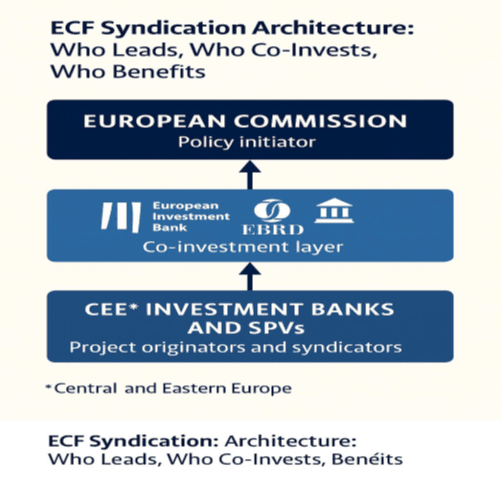




The European Commission’s Multiannual Financial Framework (MFF) for 2028–2034 signals a profound shift in how the EU allocates capital. For Central and Eastern Europe (CEE), it’s not just a matter of how much money flows—but how it flows. Instead of traditional cohesion and grant-based instruments, Brussels proposes to pivot toward loans, equity, and guarantees under a €100 billion European Competitiveness Fund (ECF). This shift will push national promotional banks, private lenders, and institutional investors into a more central role in project financing—and fundamentally change the regulatory, risk, and capital environment for CEE financial institutions.
Brussels will merge €865 bn of cohesion, CAP and social-policy money into national envelopes and create a €100 bn European Competitiveness Fund (ECF) that relies on loans, equity and guarantees rather than grants. This shift transforms the EU budget from a redistributive instrument into a co-financing engine—transferring risk to domestic balance sheets and fundamentally reshaping how banks, insurers and fintechs in Central and Eastern Europe operate and compete.
| Instrument | 2021-27 | 2028-34 (proposal) | Regulatory consequence |
| Grants (cohesion) | €213 bn to CEE | €0 inside ECF; only inside NRP | Vanishing first-loss tranches for PPPs |
| InvestEU guarantees | €26 bn envelope | Absorbed into ECF | Single point of entry for banks structuring infra-PPPs |
| Digital Europe grants | €7.5 bn | Part of ECF equity window | Fintech scale-ups must issue equity not rely on grants |
| EDF loans | Pilot phase | €25 bn callable debt under ECF | State-aid and ESM screening for defence-tech borrowers |
Table 1. From Grants to Guarantees: What Changes for CEE Finance
CEE banks that underwrote InvestEU senior debt must now re-price credit risk because EU guarantees are no longer ring-fenced.
The shift from grant-based to risk-based instruments under the ECF requires supervisors across CEE to adjust their prudential frameworks, particularly in state-aid compliance, capital classification, and solvency treatment.
3.1 ESM/Art. 107 state-aid
3.2 CRR treatment
3.3 Solvency II
The diagram below illustrates the proposed syndication flow under the ECF architecture, highlighting the role of CEE investment banks as lead arrangers and mezzanine tranche underwriters.

Figure 1: Structure of ECF Co-Financing and Syndication
The European Commission will task the EIB, EBRD and national promotional banks with co-investing every ECF ticket, effectively transforming these institutions into the gatekeepers of a new, risk-sharing co-financing architecture.
This mechanism will create a semi-permanent pipeline of approximately €100 billion in blended finance—comprising senior debt, mezzanine tranches and equity—that CEE banks can syndicate, warehouse or scale via public-private platforms.
For CEE investment banks, the ECF is not just a source of funding but a structural opportunity to reposition as long-term deal originators.
Action for CEE investment banks:
The ECF Digital Tech window (€20 billion) is not a traditional innovation grant—it is a strategic capital channel aimed at firms operating under full digital regulatory alignment. Access will be contingent on demonstrable compliance with the EU’s emerging digital finance stack: DORA, MiCA, and the forthcoming AI Act.
For fintech firms in CEE, this implies a dual transformation: both technological and regulatory.
Key prerequisites include:
Strategic implication: CEE fintech clusters (e.g., Sofia, Vilnius, Warsaw) must establish pre-qualification hubs and shared services for digital compliance to prevent exclusion from the Digital Tech pipeline.
The €40 bn ECF Clean-Tech envelope will become the EU’s primary vehicle for financing climate and energy transition projects in the next budget cycle. However, unlike previous grant-based instruments, access to ECF resources will require full alignment with the EU Taxonomy Regulation and independent third-party verification of environmental sustainability.
For Central and Eastern Europe (CEE), this marks a fundamental shift. Regions still dependent on thermal coal, such as Silesia (PL), Hunedoara (RO), and Upper Nitra (SK), will no longer receive direct subsidies unless they present a credible, bankable decarbonisation path.
Minimum eligibility requirements include:
Projects aiming to develop Carbon Capture, Utilisation and Storage (CCUS) or Small Modular Reactors (SMRs) must also undergo life-cycle emissions assessment and justify taxonomy compliance under the “do no significant harm” principle.
Unless these conditions are met, access to Clean-Tech funding will be restricted, effectively pushing regional actors—municipalities, utilities, and public development banks—to adopt EU-compliant green finance architecture.
Strategic implication for CEE governments: establish national transition finance taskforces to pre-screen and aggregate eligible projects before the ECF window opens in 2026.
Given the senior status of ECF loans, resolution authorities in CEE (e.g., the Bank Guarantee Fund in Poland or the Resolution Council in Romania) will be required to ring-fence ECF exposures within their bail-in waterfalls.
In practical terms, this means that ECF-funded liabilities must be excluded from early-loss absorption, ranking pari passu with protected claims such as insured deposits or guaranteed state liabilities. This introduces complexity in resolution planning, especially for systemically important banks that may rely on ECF instruments for capital-intensive projects.
CEE banks should take proactive steps to:
Without early alignment, banks may face regulatory arbitrage risks, increased Pillar 2 capital add-ons, or delayed access to co-financing windows.
ECF equity and quasi-equity instruments will be deployed primarily via Luxembourg SICAVs and Irish ICAVs, using EU-blessed blended finance vehicles to pool private and institutional capital. However, these vehicles come with specific cross-border tax and regulatory implications for CEE fund managers.
Key actions for the region’s asset managers include:
Without this alignment, CEE asset managers risk becoming passive allocators instead of active ECF co-originators.
| Date | Milestone | To-do |
| Q4-2025 | Council first reading | Lobby for grandfathering of existing InvestEU guarantees |
| Q1-2026 | EIB issues ECF term-sheet | Bid for mandated arranger status |
| Q2-2026 | Commission state-aid guidance | Seek comfort letters for ECF equity stakes |
| Q3-2026 | ESMA consultation on ECF disclosure | Submit comment letter on SFDR alignment |
| 2027 | Final adoption | Update ICAAP and ORSA for ECF risk weights |
Table 2. ECF Milestones & Regional To-Dos (2025–2027)
For CEE financial institutions, the post-2027 Multiannual Financial Framework (MFF) is not a grant bonanza—it is a €100 billion leveraged co-financing pipeline, where regulatory alignment, ESG credibility, and syndication capacity will determine who originates and who is sidelined.
Institutions that invest early in ESG audit readiness, adapt internal capital models to EU Taxonomy, and position themselves as mandated co-arrangers under the European Capital Fund (ECF) framework will capture long-term fee income, market share, and regulatory goodwill. Those that wait for cohesion funds will compete for a diminishing pool of grants, increasingly conditioned on green performance and transition planning.
Analytical guide explaining the ambitions, simplification, and strategic approach of the Global Europe tool.
Official breakdown of the €2 trillion MFF proposal, outlining its objectives.
Details the €200 billion Global Europe instrument and its reserve capacity for crises and enlargement support.
Assesses how pre-accession support might evolve, including €19.5 billion proposal tied to reforms.
Spanish-language summary of budget increase, policy shifts, and impact on CAP and defense.
Summarizes reactions and controversies around the €2 trillion budget proposal, focus on priorities and politics.
